HD58X Jubilee (Drop)
back to Sennheiser
back to measurements
home
published: Dec-21-2017, updated: Aug-3-2021
NO SMOOTHING is applied to the shown plots. Most measurement sites have some smoothing applied which ‘irons flat’ sharp peaks and ‘wiggles’. I do not use smoothing because some info about sound quality is lost when plots are smoothed.
Aside from a small correction of the microphone itself also some correction in the lowest frequencies is applied to the plots to compensate for the perceived loss of bass when using headphones. This is described HERE in more detail.
A ‘horizontal‘ frequency response curve on the shown frequency response plots on this website thus indicates a perceived ‘flat’ tonal signature.
ALL measurements are made with a good SEAL on a flatbed measurement rig.
The shape of your head, bone structure, pad size, pad ‘softness, (compliance), hair or no hair and or wearing glasses may (drastically) change the frequency response of some headphones, so… your personal experience may differ substantially from these plots.
Frequency response (tonal balance) is the most sound-determining aspect of headphones. A horizontal line shows audible neutral response in the plots on this website. Deviations in different severities at different frequency bands have an effect on the sound character.
The bigger the deviation the stronger the effect.
Below an aid to help determining the sound character of headphones with relation to the frequency response.

Sennheiser HD58X Jubilee (Massdrop)
This headphone is an homage to Axel Grell‘s first headphone, the HD580 Precision. In appearance it is closer to the original HD580 Jubilee (1995) which had a metal grille and carbon fibre look rather than the original HD580 (1993) which had a plastic grille and grey headband.
The HD58X Jubilee is glossy black and looks more like a HD660S, well aside from its grille that is.
It comes with an 1.8m cable terminated in a 3.5mm TRS jack and a 6.3mm adapter. It won’t come in a fancy box like the rest of the Sennheiser HD 6** line which is a good thing as that keeps the price low !
Note: I have no affiliation with Massdrop, Sennheiser or other headphone manufacturers. I have not been paid to review this headphone nor have I spent much money on it. It was sent to me for evaluation and doesn’t have to be returned.
specifications:
Type: Over ear, open
Usage: Home, studio, transportable.
Driver type: dynamic
Pads: replaceable, velours
Collapsible: No
Headphone cup connector: Sennheiser 2 pin
Cable entry: dual sided, marked
Cable: 1,8m terminated in 3.5mm TRS jack.
Driver size: 38mm
Inner Pad dimensions: depth = 20mm, Width = 40mm, height = 62mm, oval shaped
Max. power rating: 0.2W
Max. voltage: 5.5Vrms (16Vpp)
Max. current: 36mA
Max. S.P.L.: 124dB
Impedance: 150 Ω
Efficiency: 102 dB @ 1mW
Sensitivity: 110dB @ 1V
Weight: 309 g. (incl. cable)
Clamping force: high
Accessories: 6.3mm adapter
The Sennheiser HD58X Jubilee is an open dynamic over-ear headphone intended to be driven directly from desktop and portable equipment.
It will be sold for around $ 150.- which is an interesting price for Sennheiser HD6** line fans.
There is a catch though. This headphone won’t be available through the normal Sennheiser distributors nor from Sennheiser directly and is only available in limited quantities through ‘Drop‘.
You get a modern looking, light-weight Sennheiser headphone with a new type of driver.
It is glossy black except for the cups, those are matte black and the grille which is a very dark gray.
The 1.8m cable is replaceable and has the well known Sennheiser 2-pin connectors on one end and a straight 3.5mm TRS jack on the other end, a 6.3mm TRS converter is included which suggests it is intended for both portable and desktop duty.
a straight 3.5mm TRS jack on the other end, a 6.3mm TRS converter is included which suggests it is intended for both portable and desktop duty.
The cable is of HD 650 ‘thickness’ and low in microphonics. I see no need to replace the cable unless you need a different length.
The headband is comfortable and adjustable over a wide range (60mm). It is thickly padded.
Out of the box the clamping force is quite high. How to lower the clamping force is described in THIS article.
There is no isolation from outside noises as this is an open headphone. While the 3.5mm TRS jack suggests it is intended for portable usage you won’t be able to quietly enjoy music in noisier environments.
Others around you also can clearly hear what you are playing.
The ear-pads (cushions) are a bit on the stiff side. I would say they are similar to that of the HD660S and current HD650. The pads feel soft to the touch but firm in compliance.
Fit and feel is exactly like the HD6** series so when one wants to try how they fit on the head simply try out a new HD600, HD650 or HD660S in a shop somewhere.
The cups have enough room to swivel forwards and backwards as well as up and downwards. No creaky sounds when adjusting. This headphone will fit properly on most heads.
The driver is a new development and a substantially improved version of the earlier prototype (which was a bit bass shy).
It is not the same driver as used in the HD660S nor that of the HD700 nor that of the HD5** series.
Below the front and the rear side of the HD58X driver.
The damping behind the driver is differs from that of the pre-production model. Yes, the same magnet and plastic frame is used (as in many Sennheiser models) but has a different voicecoil (different impedance) and membrane/cone.
A more elaborate description of the HD58X can be downloaded HERE in pdf format with lots more measurements and experiments on the HD58X.
From beginning 2019 the HD58X are being assembled in the new Sennheiser plant in Romania. It seems some folks are being worried about this fearing quality may suffer.
I have measured a recent Romanian HD58X and in all aspects it is the exact same quality as the ones assembled in Ireland.
Efficiency and Sensitivity, or how loud it plays.
The efficiency of the (300Ω) HD580/HD600 and HD650 is around 100dB/mW. This means they can not be driven to loud levels directly from most portable music sources. An amplifier or decent headphone out from desktop equipment is about the minimum requirement.
The efficiency of the HD58X driver is slightly higher (102dB/mW). The lower impedance (150Ω) of the HD58X Jubilee makes it a easier to drive it from portable devices.
The 3.5mm TRS jack of the HD58X suggests this headphone is also intended for portable usage.
One would expect the HD58X to play noticeably louder than the 300Ω HD650 as the impedance of the HD58X is half the value.
The efficiency of the HD58X is 102dB/mW into 150Ω so it outputs 110dB when 1V is applied (sensitivity = 110dB/V).
The efficiency of the HD650 is 100dB/mW into 300Ω so it outputs 105dB when 1V is applied (sensitivity = 105dB/V).
The HD58X at the same volume setting thus plays about 5dB louder than the HD650.
The HD58X Jubilee can play quite loud when properly driven yet remains distortion free.
To reach decent volume levels with the HD58X about 2V is enough. Something decent portable players should have no trouble to provide. To reach ‘concert levels’ at least 5V is needed which most portable sources can’t deliver.
Subjective sound description:
The HD58X has the best bass extension of Sennheiser’s HD6** series headphones. Bass is present and ‘tighter’ than that of the HD650/HD6XX. No loud deep exaggerated ‘rumbles’ in this headphone even though bass extends down to 20Hz (-3dB). It won’t rattle your teeth nor appeal to bass-heads.
Integration from bass into the mids is excellent. No ‘dis-attached’ or ‘fatty’ bass at all. Bass-lines are easily followed and sound very natural. Bass extension is MUCH improved compared to the pre-production model I reviewed earlier.
The mids have a somewhat ‘warm’ character yet still have good clarity/presence. The overall sound signature is in between the HD660S and HD650 when it concerns the mids. The HD650/HD6XX sounds somewhat ‘softer’ (as in ‘romantic’). The HD58X, just like the HD660S sounds a bit ‘fresher’. The mids are dynamic and appear audibly ‘free of distortion’ as in clean and ‘natural’. The stereo image (width) is about equally ‘narrow’ as that of the HD650 and not an aspect the HD6** line-up is famous for.
To me the HD600 is the ‘brightest’ and ‘leanest’ sounding ones of the HD6** headphone line, but also slightly more ‘boring’ than the HD58X, HD660S, HD650 and HD6XX.
The HD600 and HD650, on the other hand, are slightly ‘smoother/softer’ (in texture, not level) in the upper mids/treble and a bit more ‘forward’.
The HD58X (and HD660S) are a bit more ‘dynamic’ and ‘lively’, a bit ‘fresher’ sounding.
The differences between HD58X and HD650/HD6XX are not very big though so don’t expect a totally different headphone or a much darker or bassier HD650. These are quite close.
Mids and treble are seamlessly integrated. The treble is on a ‘neutral’ level. Not recessed and not emphasised. The pre-production model had elevated and sharper treble. The current HD58X is closer to the HD660S and HD650 in treble level.
The HD58X does have good treble though. It is ‘fresher’ sounding without becoming splashy or sibilant. When you are sensitive to sibilance (like me) the HD58X is a good option.
Whether one prefers the (still sold new) HD600, HD650 (HD6XX) or the HD58X/HD660S remains a personal thing.
A short sound description would be:
A somewhat ‘warmish’ headphone with good ‘presence’ and treble quality and quantity.
One might think the HD58X Jubilee is a poor man’s HD660S and would not be far off in that assumption.
The HD660S is somewhat more ‘refined’ and ‘tighter/neutral’.
At this price-point the HD58X is very hard to beat.
The good news is that with some small modifications the HD58X can sound VERY close to the HD660S for just a fraction of the HD660S’s price.
How to achieve this can be read HERE.
Measurements:
Below the frequency response of the HD58X Jubilee (Left, Right)
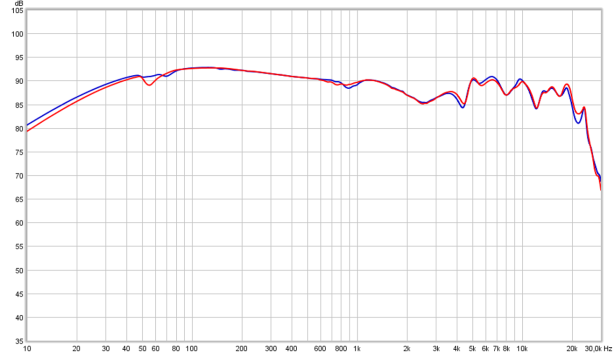
The channel matching is exemplary. One can wonder if this review sample of the production version was cherry picked by Sennheiser but don’t think so. Sennheiser is pretty good with consistency in their products and quality control.
Bass rolls off gently below 35Hz (with a perfect seal). From 25Hz to 1.5kHz the response is excellent and within +/- 3dB. Aside from the small ‘dip’ around 2.5kHz the frequency response runs all the way up to 20kHz and even beyond.
The small dip is around 2.5kHz is actually desirable as the measurement rig has no fake Pinna so in reality that part of the frequency range won’t sound recessed at all as the Pinna (ear) boosts the 2-5kHz part of the frequency range a few dB when sound is coming from the side of the head.
This headphone does not sound sharp, overly detailed nor bright.
The treble quality is good, present and detailed and not ‘coarse’ sounding.
Below a comparative measurement of a HD58X assembled in Ireland and a HD58X assembled in Romania.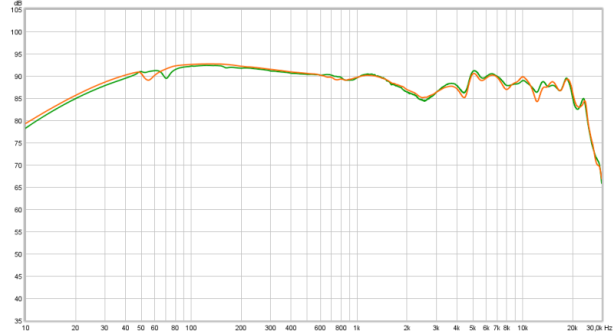
I would say there is no change in audible quality (also not in other measurable aspects) and looking at the HD58X I can’t see any differences either.
output resistance / damping-factor
As this is a dynamic headphone the frequency response can be amplifier output resistance dependent when certain higher output resistance amplifiers are used.
Instead of showing impedance plots, which are hard to ‘read’ when it comes to assessing the tonal balance change in the real world, the HD58X is measured via a low resistance output (0.2Ω) and via a high resistance output (120Ω). On a higher output resistance amplifier the output level will be lower of course due to voltage division. To compensate for this the amplifier is cranked up to the same level (+5dB at 1kHz in this case). This way the plots are overlaid and it is easier to see how the tonal balance changes. Output resistances between these 2 resistance values will result in tonal changes between the green and red trace.

The tonal balance changes when connected to a higher output resistance amplifier. The resonance frequency is around 60Hz resulting in a warmer and bassier sound.
There is about 2dB more bass.
This can make the headphone sound a little more ‘muddy/fat’. Lower bass is not boosted.
This headphone should be driven from low output resistance amplifiers. Distortion in the bass also increases so an output resistance higher than 10Ω is not recommended.
comparisons
For comparative reasons on the following page some direct comparisons of tonal balance. Below HD600 compared to the HD58X

The tonal balance of the HD58X is noticeably ‘warmer’ than that of the HD600. The HD58X has more (sub)bass. The area between 2kHz and 4kHz is about 2dB lower in the HD58X. Some HD600 owners are likely to appreciate this aspect as this is an area where some people feel the HD600 has an undesirable emphasis.
Those that are so disappointed that the HD58X is not close to an original HD580 (=HD600 with different grille and colour scheme) as shown above should take a look at the plot below. HD600 versus modified HD58X Jubilee.

The modifications are described HERE. Turns the HD58X into a HD600 with better bass extension and lowers the emphasis around 3kHz. An improved HD600 ?
Below a comparison between the HD660S and the HD58X
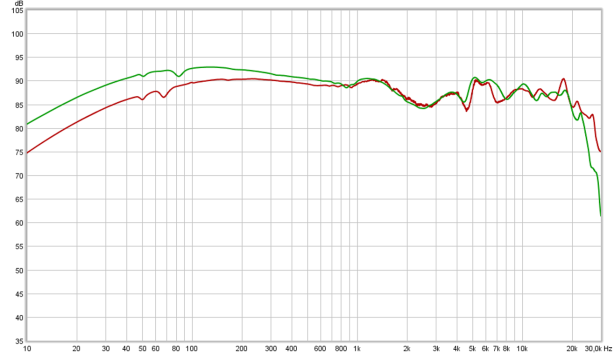
The family resemblance of the HD58X and HD660S is clearly visible in the plot. The HD58X is warmer/thicker than the HD660S. The HD660S has a more linear bass response and sounds ‘clearer’.
The HD58X thus isn’t just a cheap HD660. (the S behind the HD660 merely indicates it is a newer generation driver)
With some rather simple modifications the HD58X can be persuaded to sound really close to the HD660… without the S behind it because there is no balanced (Symmetric) cable included.

You even get a tiny bit more subbas but treble extension above 20kHz is a bit less.
Below the HD58X compared to the current HD650 (2017)

The HD58X has a similar ‘warmth’ as the current HD650 (2017) but with better bass extension. The frequency response of the current HD650 (and Massdrop HD6XX) is a bit more ‘linear’ and ‘smoother’ in upper mids and the treble. The HD58X is a bit more ‘dynamic’ and ‘fresher’ and thus do not sound the same but do have some similarities.
Below the HD58X compared to the older black driver HD650 with worn pads.

The tonal balance of the HD58X is quite similar to the old (black driver, old pads) HD650. Most found the early HD650 too warm and ‘veiled’. The HD58X I do not consider as ‘veiled’.
pads
Pads (ear cushions) not only are there for comfort but their design also has an influence of the sound of a headphone. Pads usually have a distinct influence in tonal balance/sound so it is always best to use only original pads for the best results. When a different tonal balance is found desirable one can experiment with 3rd party pads but these can be a hit or miss.
Below the HD58X with new stock pads versus HD58X with its pads compressed a few mm to mimic the compression of the pads over time when the foam inside gets softer.

The sound ‘warms’ up a tiny bit more when pads get worn a bit but not in way that is worrying
The pads on the HD660S and HD58X look a lot like the original spare pads I bought in 2015 and have similar velour cloth. When you compress the pads with your fingers and ‘feel’ the shape of the foam inside a small difference is noticeable. The HD660S and HD58X pads feel ‘less rounded’ and take a bit more force to compress. The differences are very small though. Height and shape are similar.
Seal can be an issue with closed-back headphones but is usually less of a problem for open headphones. Breaking the seal (improper fit on the head) usually means a loss of (sub)bass. The HD58X is not different than most other open headphones in this aspect. Below the effect of a seal breach is shown.
Perfect seal, Seal broken with a thin arm (temple) pair of glasses, Seal broken with a thick arm (temple) pair of glasses, seal broken with a 6.3mm TRS plug.

The tonal balance does not change very much when the fit isn’t perfect. It does lose subbass extension though.
With the seal slightly broken the tonal balance becomes very close to that of the first HD58X model (minus the 6kHz peak) and also very close to that of the modified HD58X (see further down below). Something to keep in mind when wearing thick armed glasses.
Below the distortion measurements of the HD58X Jubilee (Right channel).

The plot above shows the level differences between the signal (upper trace around 90dB SPL) and the harmonics. Most people prefer to see percentages instead of level differences so below the exact same plot except ‘normalised’ to the actual signal and level differences given in percentages.

Distortion levels in the lowest frequencies are as expected from smaller diameter drivers. Percentages above 1% are audible. From 30Hz up the distortion levels are already below 1%.
Distortion level of the 3rd order harmonics remains below 0.1% > 40Hz. All in all good performance in the bass to very good performance from the lower mids to the upper treble range.
The actual 2nd harmonic distortion above 100Hz may well be lower than 0.2% and above 2kHz even be lower than 0.1%. A shortcoming of my measurement rig.
Jude’s (Head-Fi) distortion measurements are far more accurate.
The left channel showed similar performance so is not shown.
Below the CSD (waterfall) plot of the HD58X Jubilee . (Left and Right are overlaid)

This looks really nice. No big red flags here. What can be seen though is a small and short lived resonance at around 5kHz of which I don’t think the ringing part is audible.
A different plot is the spectrum plot. This basically is a CSD (Waterfall) plot but viewed from above where the level differences are colour coded instead of being in the vertical axis. Also the frequency range of the spectrum plot is wider (from 100Hz instead of 500Hz). The time span is also bigger in the spectrum plots and expired time is shown from below to top where in the CSD the time is shown from rear to front.
Below the spectrum plot of the HD58X Jubilee (Right channel)

This plot shows a more than decent response. Some short lived and low level ‘lingering’ around 800Hz is visible but not on a worrying level nor time-frame.
Bass is actually very fast in decay.
No obvious ringing at higher frequencies.
Square-wave and impulse response
Below the square-wave response at 40Hz and 440Hz as well as 100μs pulse response.

The 40Hz square-wave shows a gentle sub-bass roll-off and is a typical response for a bandwidth limited sytem with a gradual sub-bass roll-off.
The 440Hz square-wave shows a well damped signal that follows the stimulus reasonably well and shows little to no ringing. The initial rise doesn’t reach the target line due to the dip around 2.5kHz. Most headphones, however, show much more excessive ringing and often even overshoot. Not so with the HD58X which is well damped.
The HD58X’s 440Hz square-wave response thus is decent and well but shows the ‘attack’ is lacking somewhat.
The 100μs impulse is not reaching the desired level but its waveform has a steep rising – and falling-edge and excellent in overall shape.
Short lived 5kHz ringing is visible (the sine-wave after the initial pulse).
The fact that the 100μs impulse is looking really good is an indication that the treble range has a good resolution.
outlier
I was sent a recently acquired (nov. 2018) HD58X as the owner felt it did not sound as reported by many others.
Below the frequency response of ser.# 037089
It looks like the ‘warmth’ hump, similar to that of the HD6XX and HD650, is no longer as pronounced. It looks more like a modified version w.r.t. bass-mids. Except.. the treble level is a bit (2dB) lower in level compared to 1kHz.
Given the channel matching it is unlikely to be an outlier, but it is entirely possible that there is production spread (within tolerances) during driver production. This can be solved by ‘matching’ similar curves together. It’s what I would do in such a case.
More measurements were taken of the drivers only and these too point to a (silently) revised driver. As I understand this is not on request of Massdrop.
Below a comparison between an early production HD58X, prototype production and ser.# 037089.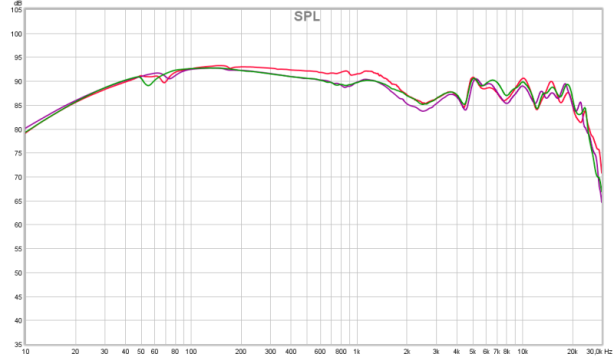
The difference between 100Hz and 1.5kHz is certainly audible.
Below the same plots except the dB scale is now 1dB/div instead of the normal 5dB/div.
The change is rather obvious. production spread or revision ?
One consequence is that the proposed modification does not work any more for HD58X with this driver and is why these findings are posted here.
The 037089 did sound ‘darker’ and less ‘dynamic/clear’ than the modified version I use.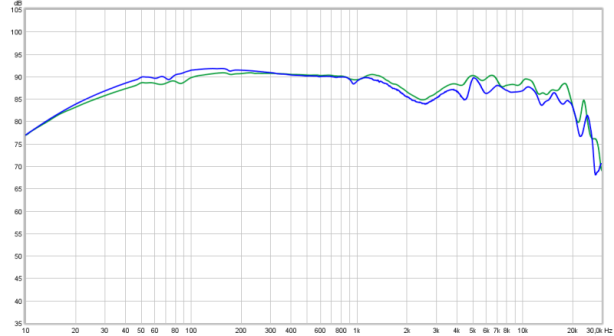
Even though the area between 20Hz and 1kHz do not differ that much (around 100Hz the 037089 has about 1.5dB more lows the difference in amount of treble is more obvious.
I am convinced this is an outlier. The weird part is that Left and Right are matched so this would suggest that there may possibly be some spread in the production.
However, a recently measured HD58X (assembled in Romania ser. # 027165) measures and performs exactly the same as the original one.
Below HD58X assembled in Ireland and a HD58X assembled in Romania

Passive filter
Fans of the HD6XX and HD650 will most likely find the HD58X too ‘fresh’ sounding. Just like those fans will tell you the HD660S does not sound as ‘smooth’ as the HD650/HD6XX.
The reason the HD58X (and HD660S as well) are a bit fresher sounding is the small ‘bump’ between 4kHz and 8kHz.
Below the (modified HD58X) and the same version but with the treble filter.

Don’t let the subtle reduction fool you in thinking the difference is so small it is impossible to hear.
The filter ONLY addresses the small elevation. Some toilet paper or other damping materials in front of the driver will also reduce the upper treble which is something that is not desirable.
The peak can be reduced a little with more damping on the rear of the driver but goes as the expense of bass extension/lows.
The notch filter below must be connected in series with the signal line of the driver.
Due to the construction of the headphone itself it is not an option to tuck it away in the cup.
The simplest way to incorporate the filter is by making a short extension lead with the components in that lead.
Only when you are aware and possibly bothered by the small peak one could use the described filter. A ready made filter is available HERE
Below the schematic diagram of the passive filter circuit for those that want to D.I.Y. one

The filter consists of just 2 components per channel.
A small inductor of 470μH (0.47mH) and a capacitor of 1.5μF in parallel to it.
This creates a ‘notch’ filter. The filter appears not to be damped but in reality it is damped by the HD58X driver itself (150Ω).
This notch filter must be connected in series with the signal line of the driver.
Due to the construction of the headphone itself it is not an option to tuck the components in the headphone cups.
The simplest way to incorporate the filter is by making a short extension lead with the components in that lead.
Of course, the 6kHz emphasis peak of the HD660S can also be lowered successfully with the exact same filter.
The inductor can be small in size. Its minimum requirements are: 75mA DC current and its resistance must be lower than 8Ω. Any of the inductors listed below can be used:
Epcos B82144A2474J000 or B82145A1474J000 or B82144F2474J000 or B82145A1474J or when it needs to be as small in size as possible the B78108S1474J000
Fastron HBCC-471J-02
Bourns JW Miller 5300-33-RC or 78F471J-RC or RL822-471K-RC
Murata 22R474C
Taiyo Yuden LHL08TB471K
The capacitor should be rated above 16V and should preferably a film type capacitor.
When all one can get is ceramic multilayer it should be rated at least 50V and be X7R.
C0G/NP0 cannot be found in this value. Anything other than X7R is not recommended.
Any of the film capacitors listed below can be used:
Epcos B82144A2474J000 or B82145A1474J000 or B82144F2474J000 or B82145A1474J
Fastron HBCC-471J-02
Bourns JW Miller 5300-33-RC or 78F471J-RC or RL822-471K-RC
Murata 22R474C
Taiyo Yuden LHL08TB471K
Kemet R82DC4150Z360J or R82DC4150Z360K or R82DC4150AA60J
Epcos B32529C0155K000 or B32529C0155J189 or B32529C0155K189
Vishay BFC237011155
WIMA MKS2C041501H00KO00 or MKS2B041501E00KO00 or MKS2C041501H00KSSD
Kameleon
The HD58X can be used with the Kameleon fitted with a HD58X module.
Below the HD58X (modified) versus stock HD58X via Kameleon.
Below the Left and Right response of a stock HD58X when driven by a Kameleon amp.
A more elaborate report of this headphone can be downloaded HERE in pdf format with more measurements and experiments on the HD58X Jubilee.
Conclusion
Is the HD58X Jubilee a re-issue of the old (1995) HD580 Jubilee?
No.. it is not… it is a different headphone with a different driver and should rather be seen as an homage to the old HD580 and not as a direct replacement / re-issue.
With some easy to perform modifications, however, it can become a more than worthy successor.
Those expecting to find a cheap HD600, just like the HD6XX is actually a cheaper HD650 with a different paint job and cable, may be disillusioned based on their preferences and references.
The HD58X is closer to a HD650 in tonal balance (but a bit ‘fresher’) than to the HD600.
BUT the modifications can turn it into a better extended and less bright HD600.
Below a picture of the HD58X without the foam and with green felt modification. The green felt was made black using a permanent marker. Also the green/gold part of the PCB was made black using the marker. Also the plastic ribs of the driver cage were made black using the marker.
To identify Right and Left a bit easier I poored some red nailpolish (not mine) in the ®.

Does removing the foam make any difference in tonal balance? stock and without grille+foam

The clamping force out of the box is very high but can be adjusted quite easily (see article).
I measured the HD58X to play only about 5dB louder than its 300Ω cousins. The HD58X will play noticeably louder from a phone/tablet than the HD6XX/HD650.
An amplifier or portable equipment (DAPs) with a decent output voltage is still highly recommended to make the HD58X sing and reach realistic listening levels.
A phone/tablet simply is not enough to play it quite loud/dynamic but at least can reach decent levels.
The HD58X does not sound exactly like a HD650/HD6XX. (that would be pointless anyway). The ‘dip’ around 2.5kHz makes the HD58X sound somewhat less ‘in your face’. The treble of the HD58X is a tad less ‘smooth’ and ‘fresher’ than that of the HD650 due to the small 6kHz ‘bump’. But there is a solution for that (see passive filter above).
The HD58X also isn’t a low cost HD660S either. The HD660S is 2-3x more expensive though. The HD660S is ‘tighter’ in the lows and somewhat ‘flatter’ = more realistic in tonal balance compared to the ‘warmer’ and relatively somewhat ‘thicker’ HD58X. Just to be clear… this does not mean the HD58X sounds ‘thick’ or overly warm. The upper mids and treble quality and quantity is pretty much the same as the HD660S though.
Fortunately, for this as well, some small and relatively easy modifications can bring it extremely close to the HD660S so basically it can easily be turned into a low-cost HD660 (without the ‘S’ unless you have a balanced HD650 cable lying around or look for an after market balanced cable).
The HD58X with modifications and filter sounds excellent and gets my highest recommendation for those looking for ‘neutral’ or ‘tonally balanced’ sound with good sub-bass response at the lowest possible price.
The HD58X is perhaps closest to a slightly ‘fresher’ and somewhat less ‘romantic/softer’ sounding HD650/HD6XX.
When considering the price level the HD58X is a very interesting headphone. For those outside of the USA shipping costs ($15) and import duties ($ ???) may increase the total price a bit more but still will get great value.
in short:
The HD58X Jubilee is an excellent entry level headphone. When looking for an excellent and realistic sound reproduction the HD58X should definitely be on your list.
With some easy to perform modifications it can sound as good as the much more expensive HD660S for a fraction of the price with a sound quality punching far above its price.
Not recommended for:
Bass-heads.
Those looking for bright splashy headphones (Grado/Beyerdynamic/AudioTechnica treble).
Those looking for V- or U-shaped headphones.
Portable usage (where isolation is needed).
Recommended for:
Home usage and indoor ‘portable’ usage (when isolation is not of importance) and ‘accuracy’ is desired.
Serious listeners that like to listen to high quality recordings.



